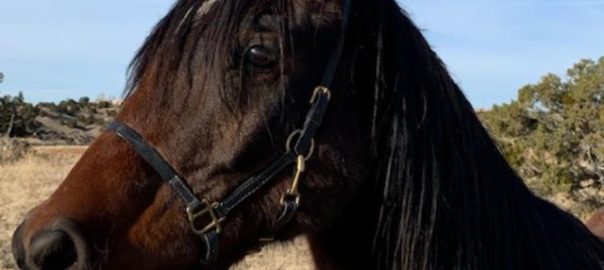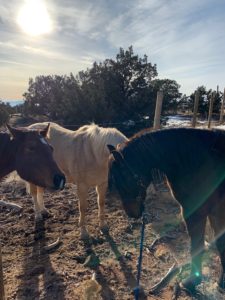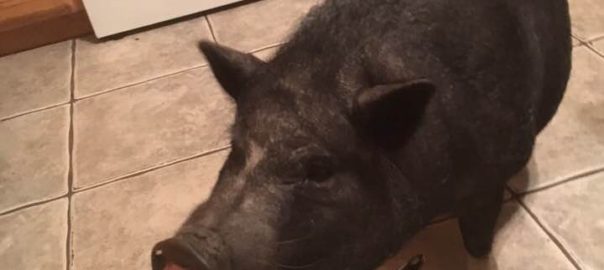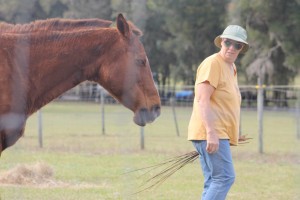We hear a lot about fear-based horse training. We don’t hear much about how bodywork can raise a horse’s fear threshold if done without regard to his/her feelings.
 It’s very common for horses to be afraid of bodywork, especially if they have received fear-based training or a number of unpleasant veterinary procedures. Of course, veterinary procedures and surgeries are often non-negotiable. When I have a procedure personally, I can only imagine what that feels like to the horse who doesn’t understand why it’s being done to him or her.
It’s very common for horses to be afraid of bodywork, especially if they have received fear-based training or a number of unpleasant veterinary procedures. Of course, veterinary procedures and surgeries are often non-negotiable. When I have a procedure personally, I can only imagine what that feels like to the horse who doesn’t understand why it’s being done to him or her.
The number of horses who have huge built in resistance is astronomical, and also some of those horses have shut down emotionally to be able to tolerate what has been done to them. Just look at the overflowing horse shelters. A huge number of these horses have arrived at the shelter abused, malnourished and neglected. Many come in afraid of the farrier, the vet, being caught, needles, lifting their hooves, being ridden – the list is endless. They may be in a lot of pain as well. They have an elaborate network of resistances holding them together, yet they are fragile, reactive or shut down, stuck in their flight/fright/freeze mode. In order to receive basic veterinary and farrier care, some may need to be sedated.

If you come to one of those horses with intrusive bodywork techniques, and that horse isn’t happy to see you, don’t take it personally. I see many of these horses who are overly cautious about what I might do to them. How do I work with them, relax them? First of all, I work on being as unthreatening as I possibly can be. And I don’t mean acting like I’m unthreatening, I mean really being unthreatening. I check in with myself – where are my resistances? Where might a horse pick up something that makes them nervous? I make sure I’m centered, that I’m not distracted, that I am just being. I have had a lot of practice doing this, but I think it’s practice worth investing in. Just be, chat with the horse a little. Lay your hand in front of the withers and talk softly. You may need to touch sore spots just to get information, but that part can wait until the horse is more relaxed.
As horse people, we can make countless decisions for our horses. One decision we can make is to hire only people who will treat our horse kindly. Of course, we need to have vets doing things that are unpleasant, as those procedures are designed to save lives. Vets are fundamentally kind, in my opinion. They are not the subject of this article.
 If your horse is continually miserable or reactive during a visit from any practitioner, it may be worthwhile to re-evaluate that professional relationship.
If your horse is continually miserable or reactive during a visit from any practitioner, it may be worthwhile to re-evaluate that professional relationship.
If it takes me half a session to get a horse relaxed enough to accept and absorb the work I’m doing, I want to look at the whole picture. Is the horse in a lot of pain? What is the horse’s trauma history? Who else works with this horse and how?
Some horses have received so much abuse that they need a lot of work emotionally and psychically. They may be in their forever home, but their trauma is very deep rooted and challenging to change. Hopefully, owners will invest in this rehabilitative process. Some horses may be enduring ongoing veterinary treatments that are stressing them out.
I worked consistently with a horse who would get better after the session but the next week, would be angry and upset again. I learned later that she was being abused by a trainer in the time in between. It is similar to when a child is being continually abused in the home, and gets better with various programs offered at school. But the child can’t move forward in development and remains in a holding pattern because the parental abuse brings the child right back to the origin of the problem, reinforcing it as other positive influences are trying to heal it. This is the agony of all child protective services as well.
I cannot move forward with the healing work if the animal is going to go back into the abusive situation.
 Sometimes I find that the owner isn’t aware of what other professionals are doing with their horses.
Sometimes I find that the owner isn’t aware of what other professionals are doing with their horses.
Finding the right professionals requires moving out of our comfort zone sometimes, where we are not expecting pain to be part of the healing process unless it is a veterinary procedure. Humans are accustomed to expecting pain – even exercise programs are designed around the “no pain – no gain” principle. When bodybuilders come for a human bodywork session, very often they want to push against me with brute force when I ask for an isometric exercise. I will then ask them to just “think it.” This can be a new concept to those who are accustomed to leaving the gym like limp noodles.
There is a time and place for everything. The work at the gym is exercise. I break it down this way – bodywork, stretching and then exercise. The bodywork should prepare or rehabilitate the body without expecting anything of it and allow it to self-correct. The stretching keeps muscles and fascia supple so the body doesn’t seize up when it gets to the exercise part. The exercise keeps the body moving, encourages circulation and therefore nourishes the blood supply and all the organs, soft tissue and structure. It’s best to have all three, but if the body is injured and can’t exercise, then the other two must be employed before we can expect more from the body. We must give the body the right information to set it on its path for healing.
If the bodywork is too vigorous and sets the individual back, then it will take days to recover from it. Many people don’t know if the bodywork their animal is receiving is doing any good, but they keep paying for it because others at the barn are using the same person. It’s a routine, sort of like getting the teeth floated, vaccinations or using the same trainer. In their minds, if they continue to do it, they are doing a good thing for their horse. Or there is peer pressure and they may be afraid to change. Important information about healthy options needs to be made available.
Bodywork that causes beings to go into recoil and not want to engage is not allowing the body to find its own self-corrective response. Why is this important? Because when we engage the self-corrective response, ask the body which way it likes to go, what’s its preference, it comes forward and there is life and change in its response. Otherwise, the body is not a participant. It’s plain and simple. The body is being “done to” rather than engaged with.
A lot of people think of bodywork as a “spa” treatment only, unaware of the vast therapeutic benefits of a good session. A session should encompass mental and spirit well-being as well as deep musculoskeletal, fascia and visceral. I say “spirit” well-being instead of spiritual because I don’t mean it to be a religious experience, I mean that we are working with the very unique, individual spirit of the animal, on a level it can absorb and embrace.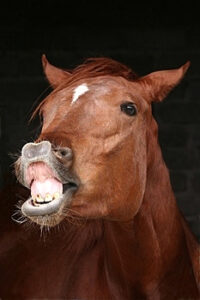
Fortunately, awareness of animals’ voices is increasing. There are fewer people thumping on horses without regard to how they are receiving therapeutic work and more people eager to take the time to really be with the horse for however short time they have to make a difference. Without burning bridges, it’s up to us to build a team of worthwhile professionals who reflect the goals we have for our equines.
What changes should you look for in your horse during or after a bodywork session?

• In most cases, the horse should have better flexibility after the session, the tissue moving under the skin fluidly, topline relaxed.
• The limbs and joints should move better, and in cases of lameness, the horse should stride better if not be free of signs of lameness. These are individual cases.
• The horse should have improved respiration.
• Any horse should have a softer or brighter look in his/her eye and be less worried, if he/she was a worried one before. The horse should be more engaged.
• A horse who is immobile due to stall rest or laminitis will have some tissue changes and perhaps improvement in small movement.
• Organic changes will also result in relaxation, dropping of tension, better overall movement; in some cases, better digestion, greater energy.





 Red isn’t a replacement, she is her own horse. She is young and curious about everything, and especially her interactions with humans and her training. She loves her training. What I’m seeing in her is that everything is an adventure. While her first years were fraught with uncertainty, fear and mistreatment, when she didn’t want anyone to catch or touch her, she has now landed somewhere where everyone listens to her and she wants to listen.
Red isn’t a replacement, she is her own horse. She is young and curious about everything, and especially her interactions with humans and her training. She loves her training. What I’m seeing in her is that everything is an adventure. While her first years were fraught with uncertainty, fear and mistreatment, when she didn’t want anyone to catch or touch her, she has now landed somewhere where everyone listens to her and she wants to listen.
